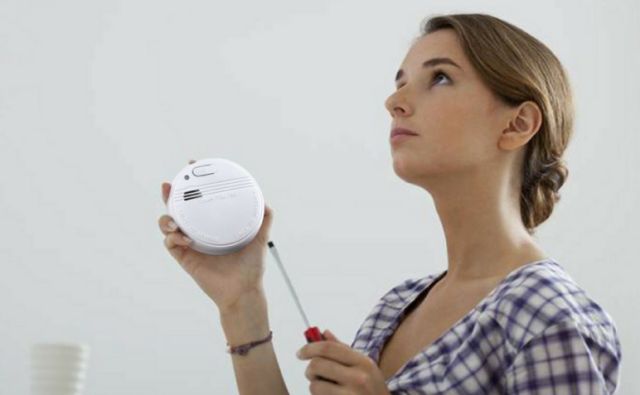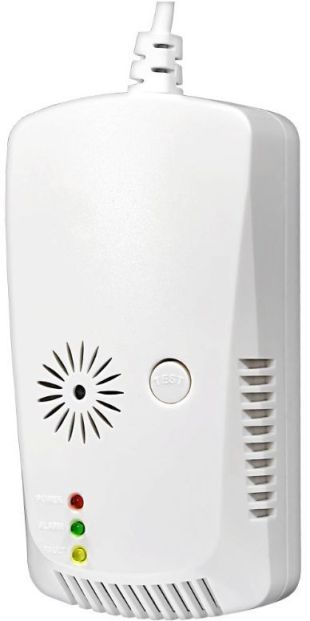Categories: How does it work
Number of views: 2105
Comments on the article: 0
How are gas leak detectors arranged and working?
The essence of the problem
In the news reports, no, no, and sometimes there are reports that in some city a gas exploded at the entrance of a residential building or a fire occurred. As a rule, the cause is the leakage of a combustible gas mixture, consisting mainly of methane with additives (propane, butane, etc.) used in gas stoves and gas boilers.
It would be good to prevent these misfortunes at the root, however, combustible gases are constantly being distributed, concentrated in rooms and lead to explosions and fires. The fault of all is human shortsightedness and imperfection of technology.

Solution
Meanwhile, there is a way to prevent such situations, or at least minimize their destructive consequences. The method is to install a gas leak detector in the room. The sensor will automatically detect the fact that the concentration of potentially hazardous gas in the air has been exceeded, thus detect a leak event and take the necessary actions to prevent catastrophic consequences.
The actions of the sensor when detecting gas can be very diverse: sending an audio signal in the room where it is installed, sending an SMS message to the owner’s phone, turning on exhaust ventilation or calling the rescue service, shutting off the gas pipeline, etc. In any case, the sensor will it is clear that there was a gas leak and it is necessary to take active steps until the evacuation of residents.
Simple sensors
The simplest home sensors are able to detect an excess of the permissible concentration of several main types of combustible gases and give an audible signal. These products are compact and easy to install in any suitable place.
Sensors of this type are intended for residential premises where a person will definitely hear a sound signal and will already know what to do - close the valve, call the emergency service, undertake evacuation, etc.
Wireless sensors
Sensors with a wireless communication unit are able to work in conjunction with a GSM alarm system. And as soon as a gas leak is detected by a sensitive element, an SMS notification will be sent to the owner on the phone and he will be able to prevent the leak on his own. In addition, the joint operation of this sensor with an alarm unit allows you to synchronize it with the fire alarm siren circuit.
Sensors controlling shutoff valves
More complex devices can control valves - solenoid valve, which will automatically be put into the “closed” position as soon as the sensor suspects that something is wrong. The human factor is minimized here.
Systems of this type are available both for domestic and industrial use, for installation in industrial facilities, in workshops, laboratories, in warehouses, etc. Sensors with shut-off valves are usually mounted on geysers and boilers. If the sensor has worked, it will be possible to return the shut-off valve to its original position only manually.

Gas Leak Sensor Device
According to the principle of action, gas leak sensors are of various types: optical, thermal, electronic. And each type is characterized by its target gas groups, the increased concentrations of which the sensor is able to detect: a mixture based on natural gas, carbon dioxide, carbon monoxide, etc.
In the case of the device is a power source - a battery or a battery, or the power source can be external - network.
For the interaction of the sensor with a gaseous external medium, the sensitive element of the primary transducer is responsible, whose characteristic, for example, electrical conductivity, changes under the influence of a gas of increased concentration.
The signal from the primary converter is compared in the measuring module of the device with a signal of a reference value that simulates an allowable gas concentration. As a result of measurements, the sensor actuator is either activated or not.
Leakage Sensor Installation Location
For all this, gas leakage sensors are not universal. Each sensor is aimed at its own group of trapped gases. This is due to the fact that some gases are heavier than air (carbon dioxide) and always flow down to the floor of the room, while others are lighter than air (methane) and therefore accumulate under the ceiling, while others are able to fill the entire space of the room (carbon monoxide). Therefore, the installation location of the sensor is selected accordingly. Natural gas sensors are installed under the ceiling, and carbon dioxide sensors are installed above the floor.
The installation locations of the sensors should be selected very carefully. It is unacceptable to place the gas leakage sensor near well-ventilated places (windows, ventilation ducts, etc.) - near them the air will be least saturated with gas during the leak.
The leakage sensor is installed close to the gas stove, cylinder, column, etc., but not on the gas equipment itself. In rooms where aerosols are used, the analyzer will not function correctly, as well as in rooms where air circulation is not clean.

Principles of gas leakage sensors
Gas leakage sensors differ in the principle of operation of the sensing element. There are sensors where a silicon wafer with a thin layer of metal oxide on the surface acts as a sensitive element.
For these sensors, gas at a certain concentration is absorbed more strongly by the sensing element and therefore the conductivity of the element therefore changes more. These sensors are suitable for residential applications. Although they are not high-precision due to their structure and inertia (they react for a long time and slowly recover), they are very simple and inexpensive. For industry (workshops, laboratories, warehouses, etc.) they will not work.
There are catalytic sensors where the gas detection process is based on its “combustion” and conversion to carbon dioxide and water. High gas air passes through a sensing element, which is a small coil of platinum wire coated with aluminum oxide and with a rhodium catalyst on the outside.
When air with a high gas content contacts the catalyst, a kind of ignition occurs, the platinum wire heats up, its resistance changes. The higher the gas concentration in the air, the more the wire heats up, the more its resistance increases. Such sensors are characterized by high accuracy and response speed. They are suitable for industrial applications.
A truly laboratory method for diagnosing air is the use of infrared leakage sensors. Industrial gas analyzers use this very principle.
The bottom line is that for many gases the bandwidth of light falls on the infrared range. Two rays with the same wavelength pass through two different media - through the studied and through the reference. Coming back, the rays already differ in strength, and the difference estimated by the detector is precisely proportional to the concentration of gas in the medium under study.

Wired and Wireless Sensors
Wired leakage sensors are powered by 220 volts. It is these sensors that are used in industry despite their high energy consumption. They are easy to maintain and fireproof even though there is far from a low voltage inside the device. However, they are completely dependent on the outlet.
Wireless sensors are powered by built-in batteries, so they can be installed even where there is no network. But they are not suitable for industry, since the operational energy consumption here is quite significant.
Operation and testing
Wipe the sensor at least once a month with a damp cloth to remove dust. Instead of a napkin, you can use a vacuum cleaner. To test a natural gas leakage sensor, a simple lighter is suitable (let gas out of the lighter on the sensor for a few seconds, but do not ignite the flame). After checking the automatic shut-off valve manually, return it to its original position.
See also on our website:
See also at bgv.electricianexp.com
:
